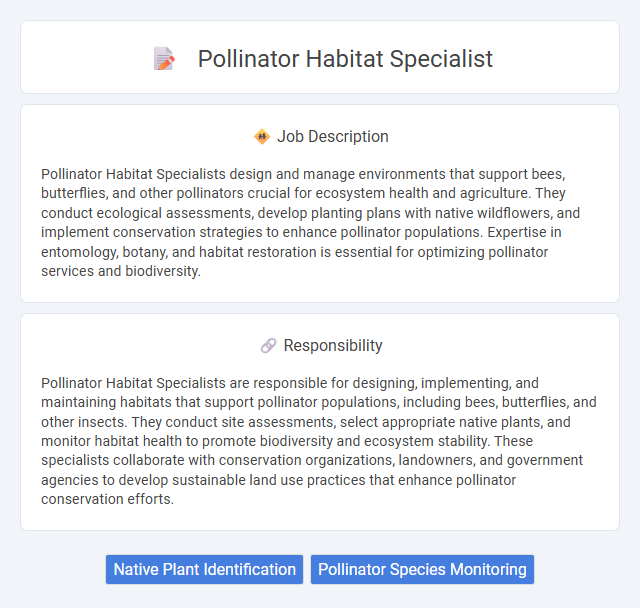
Pollinator Habitat Specialists design and manage environments that support bees, butterflies, and other pollinators crucial for ecosystem health and agriculture. They conduct ecological assessments, develop planting plans with native wildflowers, and implement conservation strategies to enhance pollinator populations. Expertise in entomology, botany, and habitat restoration is essential for optimizing pollinator services and biodiversity.
Individuals with a strong passion for environmental conservation and an interest in ecology are likely suited for a Pollinator Habitat Specialist role. Those who enjoy outdoor work and have a background or willingness to learn about native plants and pollinator species may find this job fulfilling. Candidates with physical stamina and the ability to work in varying weather conditions probably adapt well to the demands of this position.
Qualification
A Pollinator Habitat Specialist requires expertise in ecology, entomology, or environmental science with a strong focus on pollinator species and habitat restoration. Proficiency in habitat assessment, native plant identification, and knowledge of conservation practices is essential. Experience with GIS mapping, data analysis, and community outreach enhances the specialist's ability to develop and implement effective pollinator conservation strategies.
Responsibility
Pollinator Habitat Specialists are responsible for designing, implementing, and maintaining habitats that support pollinator populations, including bees, butterflies, and other insects. They conduct site assessments, select appropriate native plants, and monitor habitat health to promote biodiversity and ecosystem stability. These specialists collaborate with conservation organizations, landowners, and government agencies to develop sustainable land use practices that enhance pollinator conservation efforts.
Benefit
Pollinator Habitat Specialists likely enhance ecosystem health by creating and maintaining environments that support pollinators such as bees and butterflies. Their work probably contributes to increased plant biodiversity and improved crop yields through effective habitat management. Employing specialized knowledge in ecology, these specialists may also help mitigate pollinator population decline, supporting long-term environmental sustainability.
Challenge
The Pollinator Habitat Specialist may face challenges related to restoring and maintaining diverse ecosystems that support declining pollinator populations. Balancing agricultural practices with conservation efforts presents potential conflicts that require innovative solutions. Climate change and habitat fragmentation are likely to increase the complexity of managing sustainable pollinator habitats effectively.
Career Advancement
Pollinator Habitat Specialists play a crucial role in conserving and enhancing ecosystems by designing and managing habitats that support bees, butterflies, and other pollinators. Career advancement opportunities include moving into environmental project management, ecological consulting, or specializing in restoration ecology, often requiring additional certifications or advanced degrees. Strong expertise in native plant species, GIS mapping, and habitat assessment increases prospects for leadership roles within conservation organizations or governmental agencies.
Key Terms
Native Plant Identification
Pollinator Habitat Specialists expertly identify native plants critical for supporting local pollinator populations, ensuring the restoration and preservation of biodiverse ecosystems. Their work involves detailed knowledge of native flora characteristics, seasonal growth patterns, and pollinator-plant interactions to optimize habitat suitability. This specialization enhances conservation efforts by promoting sustainable environments essential for pollinator health and ecosystem balance.
Pollinator Species Monitoring
Pollinator Habitat Specialists conduct detailed pollinator species monitoring to assess population health and biodiversity across various ecosystems. They utilize standardized survey techniques and data analysis tools to track pollinator activity, species abundance, and habitat quality. This monitoring supports conservation efforts by informing habitat restoration projects and policy decisions aimed at protecting critical pollinator species such as bees, butterflies, and moths.
 kuljobs.com
kuljobs.com